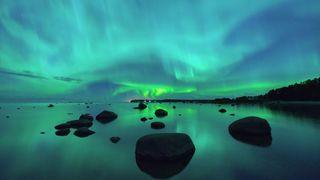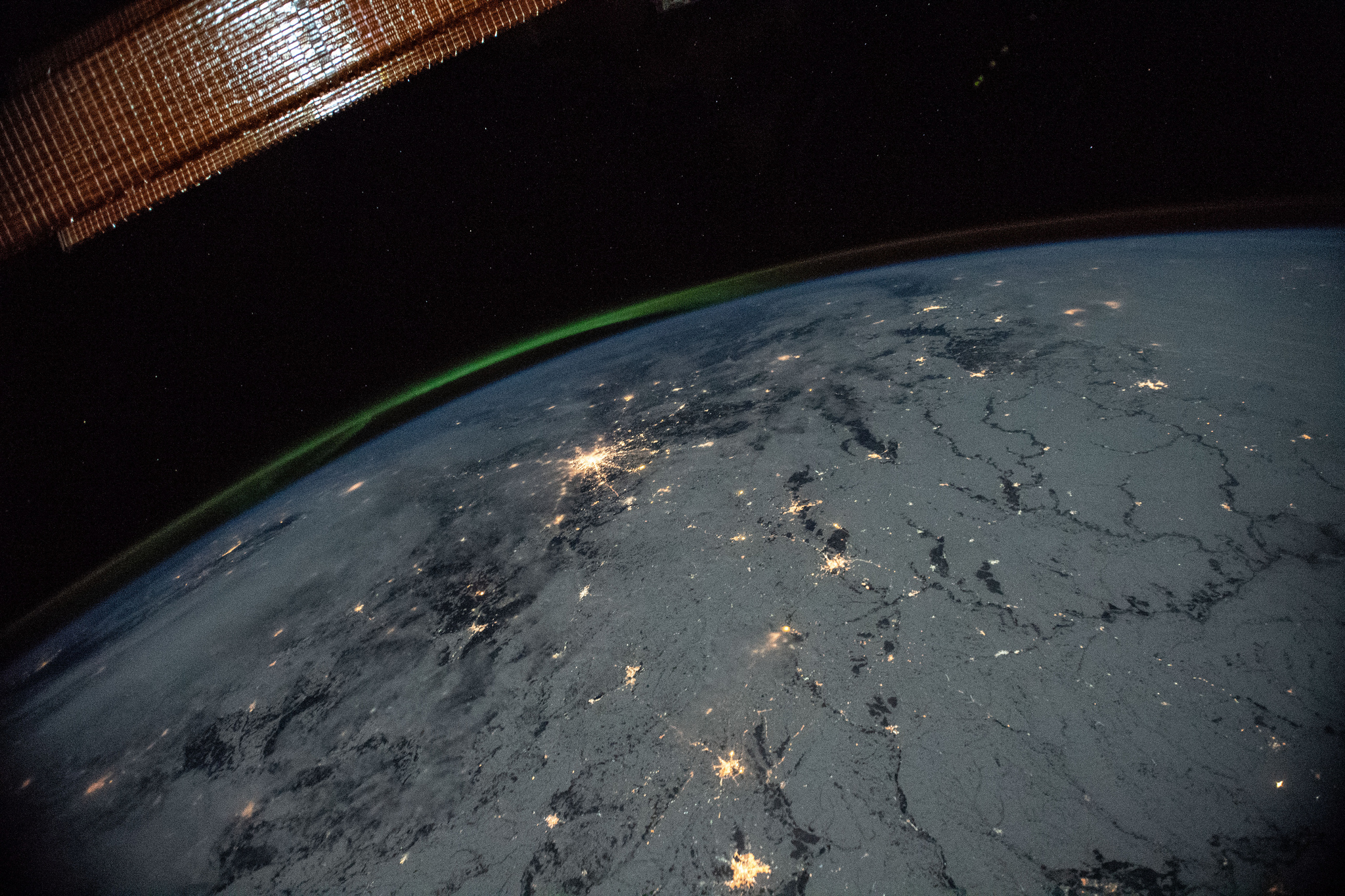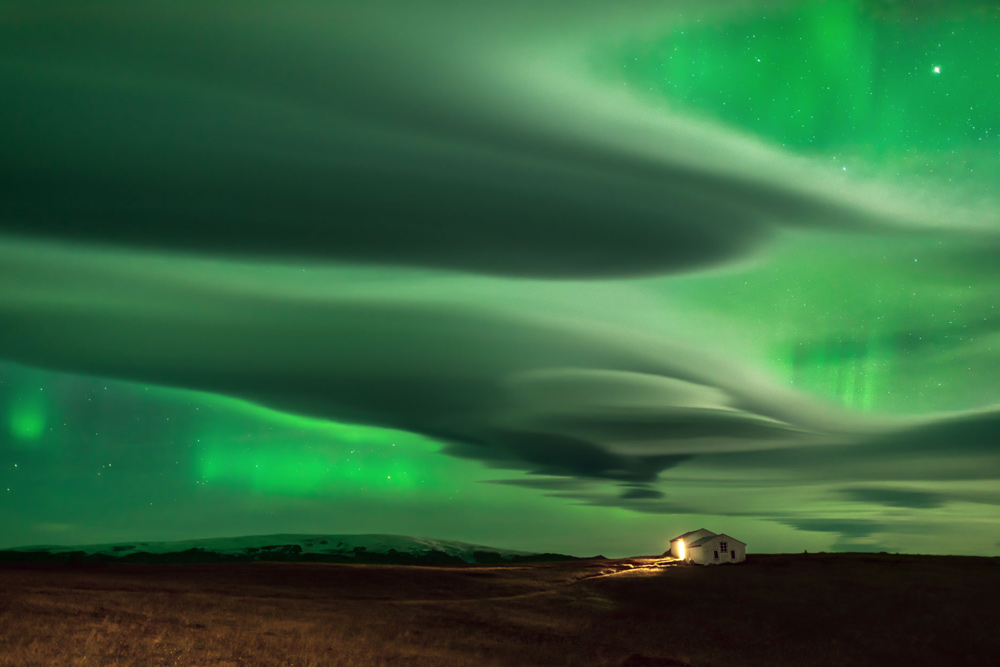what atmospheric conditions can cause auras to appear around lights at night?
Northern lights (aurora borealis): What they are & how to meet them

The northern lights, or the aurora borealis, are cute dancing waves of low-cal that accept captivated people for millennia. Just for all its beauty, this spectacular light bear witness is a rather violent effect.
Energized particles from the sun slam into World's upper temper at speeds of upwards to 45 1000000 mph (72 1000000 kph), but our planet'due south magnetic field protects the states from the onslaught.
As Earth's magnetic field redirects the particles toward the poles — there are southern lights, too, which you lot tin can read about below — the dramatic process transforms into a cinematic atmospheric phenomenon that dazzles and fascinates scientists and skywatchers alike.
Auroras over Earth: Amazing northern lights photos from space
The history of the northern lights
Though it was Italian astronomer Galileo Galilei who coined the name "aurora borealis" in 1619 — subsequently the Roman goddess of dawn, Aurora, and the Greek god of the north wind, Boreas — the earliest suspected record of the northern lights is in a xxx,000-year-onetime cavern painting in French republic (opens in new tab).
Since that time, civilizations around the world have marveled at the celestial miracle, ascribing all sorts of origin myths to the dancing lights. One Northward American Inuit legend (opens in new tab) suggests that the northern lights are spirits playing ball with a walrus caput, while the Vikings idea the miracle was light reflecting off the armor of the Valkyrie, the supernatural maidens who brought warriors into the afterlife.
Early astronomers likewise mentioned the northern lights in their records. A purple astronomer under Babylon'southward King Nebuchadnezzar 2 inscribed his written report of the phenomenon on a tablet dated to 567 B.C., for example, while a Chinese report from 193 B.C. also notes the aurora, according to NASA (opens in new tab).
The science behind the northern lights wasn't theorized until the plow of the 20th century. Norwegian scientist Kristian Birkeland proposed that electrons emitted from sunspots produced the atmospheric lights after being guided toward the poles past Globe's magnetic field. The theory would eventually prove correct, but not until long after Birkeland'south 1917 expiry.

What are the northern lights?
At any given moment, the sun is ejecting charged particles from its corona, or upper atmosphere, creating what's chosen the solar current of air. When that wind slams into Earth'due south ionosphere, or upper atmosphere, the aurora is born. In the Northern Hemisphere, the phenomenon is chosen the northern lights (aurora borealis), while in the Southern Hemisphere, it's chosen the southern lights (aurora australis).
"These particles are deflected towards the poles of Earth by our planet'due south magnetic field and interact with our temper, depositing free energy and causing the atmosphere to fluoresce," said astronomer Billy Teets, the manager of Dyer Observatory at Vanderbilt University in Nashville, Tennessee.
The bright colors of the northern lights are dictated by the chemical composition of Earth's atmosphere.
"Every type of atom or molecule, whether it's atomic hydrogen or a molecule like carbon dioxide, absorbs and radiates its own unique set of colors, which is analogous to how every human being has a unique set of fingerprints," Teets told Space.com. "Some of the dominant colors seen in aurorae are red, a hue produced by the nitrogen molecules, and dark-green, which is produced past oxygen molecules."
While solar current of air is constant, the lord's day's emissions go through a roughly 11-year cycle of action. Sometimes at that place's a lull, just other times, there are vast storms that bombard Earth with farthermost amounts of energy. This is when the northern lights are at their brightest and most frequent. The last solar maximum, or period of peak action, occurred in 2014, according to the U.South. National Oceanic and Atmospheric Administration (opens in new tab) (NOAA), placing the next 1 in approximately 2025.
Despite plenty of advances in heliophysics and atmospheric science, much about the northern lights remains a mystery. For example, researchers weren't entirely sure how the energized particles in the solar current of air go accelerated to their extraordinary speeds (45 million mph) until June 2021, when a study published in the journal Nature Communications (opens in new tab) confirmed that a phenomenon called Alfvén waves gave the particles a boost. Alfvén waves are low-frequency yet powerful undulations that occur in plasma due to electromagnetic forces; the electrons that create the northern lights "surf" along these waves in Earth'southward atmosphere, accelerating quickly.
NASA is also on the hunt for clues well-nigh how the northern lights work. In 2018, the space bureau launched the Parker Solar Probe, which is currently orbiting the sun and volition eventually become close plenty to "touch" the corona. While there, the spacecraft will collect information that could reveal more most the northern lights.

Northern lights, southern lights and STEVE
On Earth, the northern lights' analogue in the Southern Hemisphere is the southern lights — they are physically the same and differ only in their location. Every bit such, scientists look them to occur simultaneously during a solar storm, but sometimes the onset of 1 lags behind the other.
"One of the more challenging aspects of nightside aurorae involves the comparison of the aurora borealis with the aurora australis," said Steven Petrinec, a physicist at the aerospace company Lockheed Martin who specializes in magnetospheric and heliospheric physics.
"While some auroral emissions occur in both hemispheres at the same magnetic local fourth dimension, other emissions announced in opposing sectors in the two hemispheres at different times — for case, pre-midnight in the Northern Hemisphere and post-midnight in the Southern Hemisphere," Petrinec told Space.com.
The hemispheric asymmetry of the aurora (opens in new tab) is due in part to the sun'southward magnetic field interfering with Earth's magnetic field, but enquiry into the phenomenon is ongoing.
Another aurora-like occurrence on Earth is STEVE ("Strong Thermal Emission Velocity Enhancement"). Similar the northern and southern lights, STEVE is a glowing atmospheric phenomenon, simply information technology looks slightly unlike from its undulating auroral counterparts. "These emissions announced equally a narrow and distinct arc, are typically purple in color and often include a green sentinel-argue structure that slowly moves due west," Petrinec said.
STEVE is too visible from lower latitudes, closer to the equator, than the auroras.
A 2019 written report published in the journal Geophysical Research Messages (opens in new tab) discovered that STEVE is the result of two mechanisms: The mauve streaks are acquired by the heating of charged particles in the upper temper, while the picket-contend construction results from electrons falling into the atmosphere. The latter process is the same driver of the aurora, making STEVE a special kind of aurora hybrid.
Auroras on other worlds
Auroras occur on other planets, too — all that'southward required to make an aurora is an atmosphere and a magnetic field.
"Auroras have been seen in the atmospheres of all the gas behemothic planets, which is not surprising, since these planets all have robust magnetic fields," said Jeff Regester, an teacher of physics and astronomy at High Point Academy in N Carolina. "More surprisingly, auroras accept also been discovered on both Venus and Mars, both of which have very weak magnetic fields."
Indeed, scientists have catalogued three different types of Martian auroras. 1 occurs but on the planet's dayside, some other is a widespread nighttime characteristic fueled by strong solar storms and another is a much patchier nightside phenomenon.
The Promise Mars orbiter, the United Arab Emirates' first-ever interplanetary mission, managed to capture the discrete nocturnal aurora shortly after arriving at the Carmine Planet in early on 2021. The probe'south observations could aid scientists ameliorate understand this mysterious miracle.
Jupiter's magnetic field is 20,000 times stronger than that of Globe, and then the behemothic planet'southward auroras are far brighter than the ones that blaze in our skies. And the Jupiter lights aren't merely driven by the solar wind: Almost of the particles that crusade the planet's auroras are blasted into space by its close-orbiting moon Io, the most volcanic body in the solar system.
Astronomers have even caught glimpses of apparent auroral activity in other solar systems. For example, two Oct 2021 studies reported the detection of radio waves emitted by multiple cerise dwarfs, stars smaller and dimmer than our ain sun.
These radio waves are likely associated with a sort of "backward" aurora, one that flares up near stars and is driven by particles released past close-orbiting planets, researchers said.
"Our model for this radio emission from our stars is a scaled-upwards version of Jupiter and Io, with a planet enveloped in the magnetic field of a star, feeding material into vast currents that similarly power brilliant aurorae," Joseph Callingham, a radio astronomer at Leiden University in the netherlands and the Dutch national observatory ASTRON and co-author on both new studies, said in a argument (opens in new tab). "It's a spectacle that has attracted our attending from calorie-free-years away."
These feeder planets remain hypothetical at the moment; nobody has yet discovered any circling the crimson dwarfs that the team studied. But if Callingham and his colleagues are right, astronomers may accept a powerful new planet-hunting technique at their disposal.
Auroras are expected to be relatively common in the skies of exoplanets as well. Just nosotros'll accept to become meliorate looks at these faraway worlds to see their lite shows directly.
Where and when to run across the northern lights
Seeing the northern lights with your own eyes is a bucket-list detail for astronomy lovers and travelers alike. Fortunately, they occur frequently.
"The northern lights are happening 24 hours a day, 7 days a week, 365 days a year," said photographer Chad Blakely, owner of the northern lights tour company Lights Over Lapland (opens in new tab). Only that doesn't mean they're easy to spot; y'all demand to be at the right place at the right time.
The best identify to come across the northern lights is whatsoever destination in the "auroral zone," the area within an approximately 1,550-mile (2,500 kilometers) radius of the North Pole, according to the Tromsø Geophysical Observatory (opens in new tab) in Norway. That's where the aurora most ofttimes occurs, though the miracle tin can creep farther south during particularly potent solar storms.
Related: Where to see the northern lights: 2022 aurora borealis guide
In March 1989, for case, a powerful solar eruption made the northern lights visible, admitting briefly, to people as far due south equally Honduras. (At that place were some negative consequences besides, however: The geomagnetic storm that supercharged the aurora likewise temporarily knocked out electricity beyond the entire Canadian province of Quebec.)
Within the auroral zone, it'due south all-time to exist equally far abroad from city lights as possible to maximize visibility. But it's pretty tricky to get into the middle of the Chill wilderness, fifty-fifty with a guide, so it's best to base yourself in a destination with solid infrastructure, like Fairbanks, Alaska; Yellowknife, Canada; Svalbard, Norway; Abisko National Park, in Sweden; Rovaniemi, Finland; and pretty much anywhere in Iceland.
The best time of year to see the northern lights is between September and Apr, when the sky gets dark enough to see the aurora. (Far northern locales experience the midnight sun, or 24 hours of daylight in the summer.) The most action usually happens betwixt 9 p.grand. and three a.m., co-ordinate to the Geophysical Institute of the University of Alaska Fairbanks (opens in new tab). Keep the moon phases in mind, as a bright total moon might fill the night sky with light. Check local conditions forecasts likewise, considering yous won't exist able to spot the aurora through the clouds.
You can likewise monitor aurora forecasts from the University of Alaska Fairbanks' Geophysical Institute (opens in new tab) and NOAA, which offers both three-twenty-four hours (opens in new tab) and 30-minute forecasts (opens in new tab).
Additional resources
You tin can learn more than nearly the northern lights at NASA's aurora page (opens in new tab). NOAA'south Space Atmospheric condition Prediction Eye provides a xxx-minute aurora forecast hither (opens in new tab), and you can watch livestreams of the northern lights via Explore.org (opens in new tab).
If you desire to read more than about Kristian Birkeland, check out "The Northern Lights: The True Story of the Man Who Unlocked the Secrets of the Aurora Borealis (opens in new tab)" (Vintage, 2002), past Lucy Jago. And you can keep up to appointment on NASA's sun-kissing Parker Solar Probe mission past post-obit its web log (opens in new tab).
Bibliography
- Barton, Thousand. "Legends of the northern lights," CBC News, Dec. x, 2019. https://newsinteractives.cbc.ca/longform/legends-of-the-northern-lights
- Callingham J. et al. "The population of Chiliad dwarfs observed at low radio frequencies," Nature Astronomy, Vol. 5, December 2021. https://doi.org/10.1038/s41550-021-01483-0
- NASA, "FAQ: How does the solar bike affect Earth's climate?" https://www.nasa.gov/mission_pages/sunearth/solar-events-news/Does-the-Solar-Cycle-Touch-Earths-Climate.html
- NASA, "The history of auroras," 2006. https://www.nasa.gov/mission_pages/themis/auroras/aurora_history.html
- Nishimura Y. et al. "Magnetospheric signatures of STEVE: Implications for the magnetospheric energy source and interhemispheric conjugacy," Geophysical Enquiry Letters, Vol. 46, Effect xi, Apr 2019. https://doi.org/x.1029/2019GL082460
- Schroeder, J.W.R. et al. "Laboratory measurements of the physics of auroral electron acceleration by Alfvén waves," Nature Communications 12, 3103, June 2021. https://doi.org/ten.1038/s41467-021-23377-5
Follow us on Twitter @Spacedotcom (opens in new tab) or on Facebook (opens in new tab) .
Join our Infinite Forums to keep talking space on the latest missions, night sky and more! And if you take a news tip, correction or annotate, permit us know at: community@space.com.
Source: https://www.space.com/15139-northern-lights-auroras-earth-facts-sdcmp.html
0 Response to "what atmospheric conditions can cause auras to appear around lights at night?"
Post a Comment